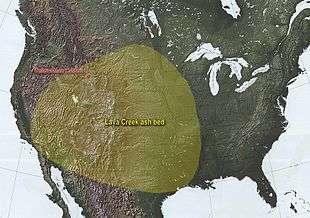Lava Creek Tuff

Extent of the Lava Creek ash bed.

Tuff Cliff showing the Lava Creek Tuff formation.
The Lava Creek Tuff is a tuff formation in Wyoming, created during the Lava Creek eruption around 630,000 years ago,[1] which formed the Yellowstone Caldera.[2]
The Lava Creek Tuff is distributed in a radial pattern around the caldera and is formed of 1000 km3 (240 mi3) of ignimbrites.[3]
The tuff has been exposed by erosion at Tuff Cliff along the Gibbon River.
Lava Creek Tuff ranges in color from light-gray to pale red in some locales. Rock texture of the tuff ranges from fine-grained to aphanitic and is densely welded. The maximum thickness of the tuff layer is approximately 180–200 m (590–660 ft).[4]
See also
References
- ↑ Matthews, Naomi E.; Vazquez, Jorge A.; Calvert, Andrew T. (2015). "Age of the Lava Creek supereruption and magma chamber assembly at Yellowstone based on 40Ar/39Ar and U-Pb dating of sanidine and zircon crystals". Geochemistry, Geophysics, Geosystems. 16: 2508–2528. doi:10.1002/2015GC005881. Retrieved August 14, 2016.
- ↑ "Undine Falls, Lava Creek, Yellowstone National Park". Yellowstone Volcano Observatory. Archived from the original on 2012-02-04. Retrieved September 16, 2005.
- ↑ Lisa Morgan (February 10, 2004). "Yellowstone Lake Geology Talk Transcript - The floor of Yellowstone Lake is anything but quiet: Volcanic and hydrothermal processes in a large lake above a magma chamber". Yellowstone Science Talks. Archived from the original on 2004-05-01. Retrieved September 16, 2005.
- ↑ "U.S. Geological Survey Scientific Investigations Map 2816" (PDF). Retrieved September 16, 2005.
This article is issued from Wikipedia - version of the 9/6/2016. The text is available under the Creative Commons Attribution/Share Alike but additional terms may apply for the media files.